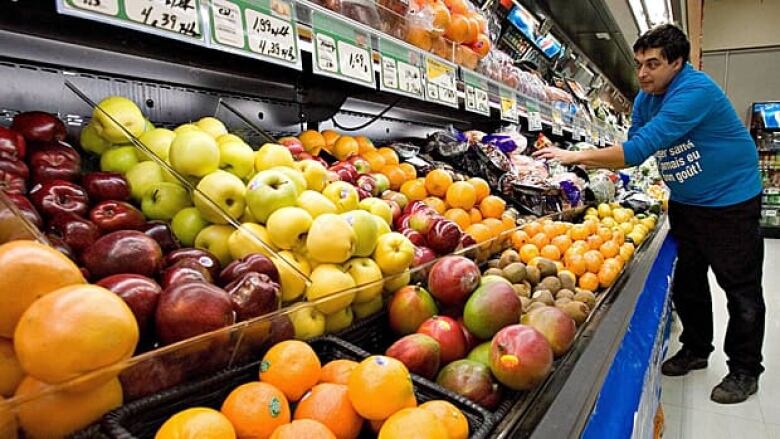Food eats up less of our spending, but costs us more

When Canadians buy the turkey, turnip and other fall fare they'll put on their Thanksgiving table this weekend, they wont be dipping into their householdbudget as deeply as they used to.
Food prices have consistently trended higher over the years, but the percentage of householdspending devoted to food has fallen significantly.
Average share of household spending on major items
1969
Food - 18.7 per cent
Shelter - 15.2 per cent
Clothing - 8.1 per cent
Transportation - 13.1 per cent
Personal taxes - 13.5 per cent
2009
Food - 10.2 per cent
Shelter - 19.8 per cent
Clothing - four per cent
Transportation - 13.7 per cent
Personal taxes - 20.2 per cent
Source: Statistics Canada
Statistics Canada figures show that, in 1969, food ate up 18.7 per cent of spending in the average household. By 2009, that number had fallen to 10.2 per cent.
That 18.7 per cent level in 1969 put food at the top of the household spending list, ahead of shelter, personal taxes, clothing and transportation.
Fast forward four decadesa period of time that also saw an increase in Canadians' average incomesand the percentage of household spending devoted to food has fallen to near the bottom of that same list.
"Just the fact that it's dropped in ranking quite steadily and uniformly over that period of time is striking in the sense that it's a fairly direct measure of how much[spending] discretion we have on things other than food and necessities," says Bradley Snider, a Statistics Canada statistician.
In 1976, the average income was $7,597, a figure that translates into $28,200 in 2009 dollars. In 2009, the average Canadian income was $37,300.
Other factors also come into playwhen it comes tounderstanding the shift in household spending.
"The thing about food compared to other consumption items is that there's a bit of an upper limit on how much you can consume," Snider says.
"As our real wealth increases, then up to a certain point people consume more or better quality [food]. But past a certain point, the proportion you have to devote to food just starts declining."
Relatively well off
Still, Canada is relatively well off compared to other countries in the world.
"Were a pretty fortunate country where we dont have to spend most of our income on food," says Snider. "It's a result of a lot of different things. It's a complex combination of efficient production on the cost side and income on the purchasing side."
The food production changes are vast. In the 1960s, a farmer on a 60-horsepower tractor pulling a three-furrow plough was a relatively common sight. Now, such a sight would seemquaint beside a 250-horsepower tractor roaring down a field.
"There have big efficiency gains not only at the farm level, but also at the processing level and the retail level that are able to deliver products from the farmer to the consumer at relatively low cost," says Alfons Weersink, a professor in the department of food, agricultural and resource economics at the University of Guelph.
But while food may be produced in Canada at that relatively low cost, consumers still have seen the bottom line keep rising on their grocery bills.
Rising prices
Food prices rose 4.3 per cent in July, according to Statistics Canada, matching the increase in the previous month.
And historically, the numbers have only gone up over time. For example, a Statistics Canada review of prices for selected food products shows milk prices have increased 863 per cent from 1961 to 2011. Chicken prices have climbed 733 per cent. And potatoes have gone up 1,265 per cent.
Weersink says many factors play into the prices Canadians pay for food. And the farmer isn't getting the lion's share.
On average, Weersink says, the farmer sees about 20 cents of every $1. But that number varies significantly depending on the product.
"The more processing involved, the lower the share," says Weersink, noting that with products such as eggs and milk, the farmers share could be as high at 60 cents.

According to the Canadian Wheat Board, a loaf of bread that might cost $2 or $3 in the grocery storegenerates about 13 cents forthe wheat grower.
The lower dollar
"Part of the price increase that we saw over the last several years is due to higher energy prices," says Weersink.
But while Weersink hesitates to predict what exactly may happen to Canadian food prices, he sees some factors that could be influential.
"It looks like agricultural commodity prices are going to remain strong for a while," he says.
Plus, a falling Canadian dollar could also push prices up: Canada buys many of itsfruits and vegetables from the U.S., and if the loonie declines, those items become more expensive.
At the same time,other factors could moderate any increases, Weersink says, noting a softness in world energy prices and within the global economy itself could translate into "no push-up in transportation costs."
And then there's Target.
The U.S. retailer is coming to Canada in 2013, and Weersink says it could add competition among food retailers and moderate any potential price increases.
'Fewer discretionary funds'
While Canadians enjoy what could be considered relatively low food prices compared to elsewhere in the world, and spend a relatively low share of income on their food, that's not to say everyone in the country has an easy time putting food on the table.
Canadians with the lowest incomes spendproportionately more on food.
According to Statistics Canada figures, Canadian households within the bottom fifth of household spending devoted 16.3 per cent oftheir budget onfood in 2009, compared to the 10.2 per cent for the average household.
Figures from Food Banks Canada show that 867,948 Canadians were assisted by food banks in March 2010, a number the organization said was the highest level on record. Food bank use had risen 19 per cent since 2000, the organization said.
Food Banks Canada has been closely following food prices and is "deeply concerned" about Canadians who are struggling to provide themselves and their families with an adequate supply of food, says executive director Katharine Schmidt.
"Compared to high and middle-income households, families assisted by food banks spend a larger proportion of their income on the basicsfood, shelter, gas, energyleaving fewer discretionary funds in the case of emergencies/unexpected expenses," Schmidt said in an email.
"In short, people living on low incomes will be disproportionately affected by changes in the price of food."












_(720p).jpg)


 OFFICIAL HD MUSIC VIDEO.jpg)
.jpg)



























































































